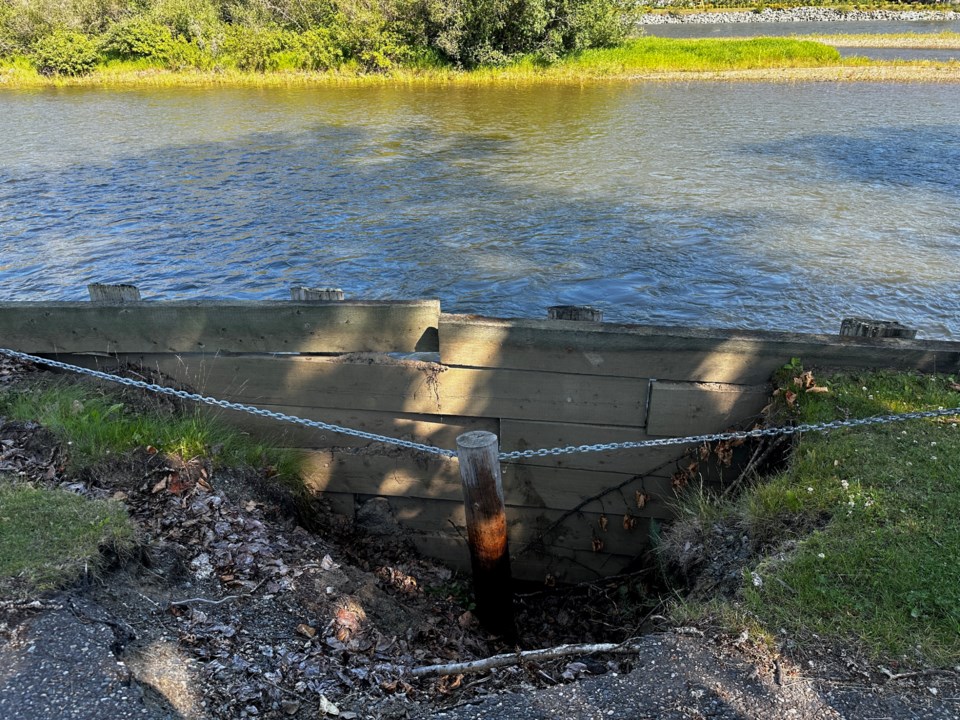At first glance, it’s easy to assume the city has forgotten about the Heritage River Trail. The route through some of Prince George’s most scenic riverfront — particularly from the Cameron Street Bridge to Cottonwood Island Park — now has detours and barricades, with some sections reduced to treacherous slivers of asphalt clinging to crumbling banks.
Locals are right to be frustrated. What was once a crown jewel of outdoor recreation is now littered with debris, eroded shoulders and the unsettling sight of concrete barriers where families used to ride, walk and explore freely.
But despite the visible neglect, the truth is more complicated — and more important — than it first appears.
The damage, for starters, isn’t man-made. It’s the result of intense natural forces: spring runoff, shifting sediment and an ice jam that caused significant destruction a few years ago.
And while it may seem like the city has dragged its feet in repairing what’s been lost, the delay stems not from apathy but from a complex web of environmental regulations and logistical constraints.
Cottonwood Island Park and the Nechako River are designated critical habitat for the endangered white sturgeon. That means any erosion mitigation or trail repair within this zone must be approved by Fisheries and Oceans Canada, with strict conditions and costly offsetting measures attached.
On the opposite side of the river, Northern Lights Winery, the Freshwater Fisheries Prince George trout facility and a private residence — at their cost and with permitting assistance from the City of Prince George — had riprap installed in 2016 to prevent the erosion of their banks. The project has proven successful.
While the city worked to protect the north shore, it missed the opportunity in 2015 and 2016 to protect the south shore and our riverfront trail network. Whether that decision was due to a lack of vision or an unwillingness to allocate funding, the result is the rapid deterioration of a beloved walking path.
In 2019, a change to the federal Fisheries Act made the environmental regulation requirements even more rigorous. Routine repairs or installing new sections of riprap are now far more expensive and take much longer to carry out.
This doesn’t mean the city has done nothing. In fact, trail renewal continues every year, with 2.1 kilometres of gravel resurfacing completed in 2024. Bridges have been rebuilt; park amenities upgraded.
Meanwhile, groups like the Spruce City Wildlife Association (SCWA) are working on complementary habitat restoration projects, such as clearing sediment from a clogged side channel and stabilizing banks using eco-friendly techniques involving willows and root structures.
Of course, these explanations don’t erase the very real concerns raised by residents — especially those dealing with dangerous rebar, broken fences or overgrown trails.
But this work takes both time and money, while navigating a frustrating amount of red tape.
As SCWA president Dustin Snyder pointed out, even something as simple as slope stabilization can be delayed by a single beaver felling the very trees meant to hold the bank in place. Add in denied grant applications and multi-agency coordination, and it’s clear that repairing the trail isn’t as easy as just laying down fresh gravel.
While endangered species protections may limit what can be done at the river’s edge, that doesn’t mean the city is powerless.
As Robin Draper of the Cranbrook Hill Greenway Society rightly suggested, new trail alignments set farther from the water could be explored — especially along sections where erosion has left little room to manoeuvre.
Public frustration is valid. So is public expectation. However, it’s important to recognize that some problems are not simply the result of neglect — they’re the byproduct of trying to navigate federal red tape.
We are situated on two major rivers, with all the environmental responsibilities that come with that geography. Choosing to protect our fish, our ecosystems and our shoreline doesn’t mean we abandon public infrastructure — it means we find smarter, more sustainable ways to rebuild it.
In the meantime, we should remember that things aren’t always as simple as they appear.
Sometimes the path forward involves taking a detour. Let’s ensure the Heritage River Trail becomes one we can be proud of, and one that future generations can enjoy.
Share your opinion with a letter to the editor: [email protected].



